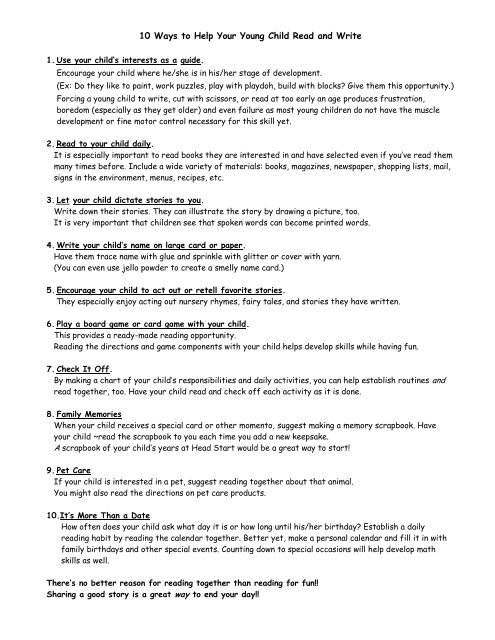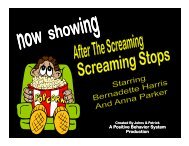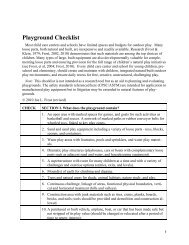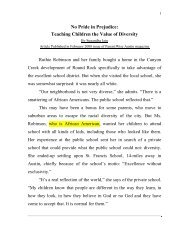Family Literacy Nights - Texas Association for the Education of ...
Family Literacy Nights - Texas Association for the Education of ...
Family Literacy Nights - Texas Association for the Education of ...
You also want an ePaper? Increase the reach of your titles
YUMPU automatically turns print PDFs into web optimized ePapers that Google loves.
10 Ways to Help Your Young Child Read and Write1. Use your child’s interests as a guide.Encourage your child where he/she is in his/her stage <strong>of</strong> development.(Ex: Do <strong>the</strong>y like to paint, work puzzles, play with playdoh, build with blocks? Give <strong>the</strong>m this opportunity.)Forcing a young child to write, cut with scissors, or read at too early an age produces frustration,boredom (especially as <strong>the</strong>y get older) and even failure as most young children do not have <strong>the</strong> muscledevelopment or fine motor control necessary <strong>for</strong> this skill yet.2. Read to your child daily.It is especially important to read books <strong>the</strong>y are interested in and have selected even if you’ve read <strong>the</strong>mmany times be<strong>for</strong>e. Include a wide variety <strong>of</strong> materials: books, magazines, newspaper, shopping lists, mail,signs in <strong>the</strong> environment, menus, recipes, etc.3. Let your child dictate stories to you.Write down <strong>the</strong>ir stories. They can illustrate <strong>the</strong> story by drawing a picture, too.It is very important that children see that spoken words can become printed words.4. Write your child’s name on large card or paper.Have <strong>the</strong>m trace name with glue and sprinkle with glitter or cover with yarn.(You can even use jello powder to create a smelly name card.)5. Encourage your child to act out or retell favorite stories.They especially enjoy acting out nursery rhymes, fairy tales, and stories <strong>the</strong>y have written.6. Play a board game or card game with your child.This provides a ready-made reading opportunity.Reading <strong>the</strong> directions and game components with your child helps develop skills while having fun.7. Check It Off.By making a chart <strong>of</strong> your child’s responsibilities and daily activities, you can help establish routines andread toge<strong>the</strong>r, too. Have your child read and check <strong>of</strong>f each activity as it is done.8. <strong>Family</strong> MemoriesWhen your child receives a special card or o<strong>the</strong>r momento, suggest making a memory scrapbook. Haveyour child ~read <strong>the</strong> scrapbook to you each time you add a new keepsake.A scrapbook <strong>of</strong> your child’s years at Head Start would be a great way to start!9. Pet CareIf your child is interested in a pet, suggest reading toge<strong>the</strong>r about that animal.You might also read <strong>the</strong> directions on pet care products.10.It’s More Than a DateHow <strong>of</strong>ten does your child ask what day it is or how long until his/her birthday? Establish a dailyreading habit by reading <strong>the</strong> calendar toge<strong>the</strong>r. Better yet, make a personal calendar and fill it in withfamily birthdays and o<strong>the</strong>r special events. Counting down to special occasions will help develop mathskills as well.There’s no better reason <strong>for</strong> reading toge<strong>the</strong>r than reading <strong>for</strong> fun!!Sharing a good story is a great way to end your day!!





